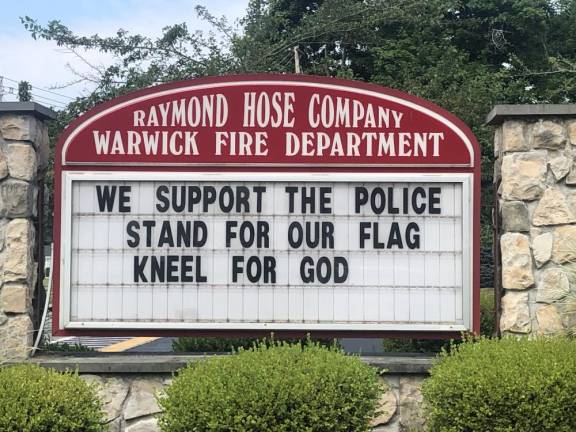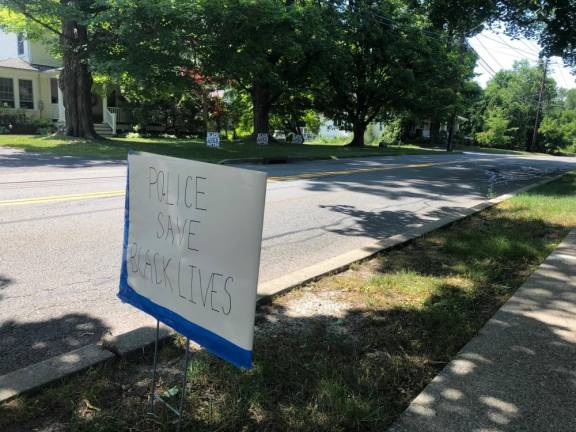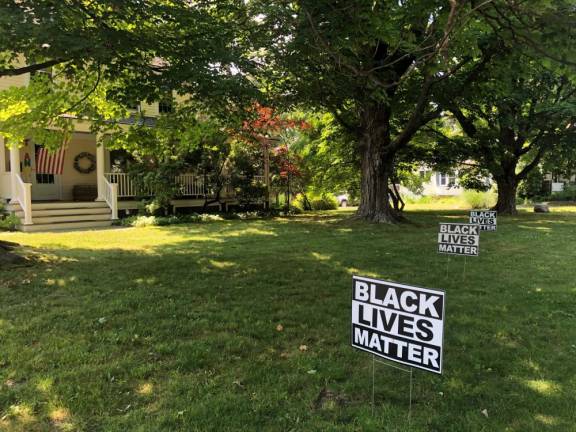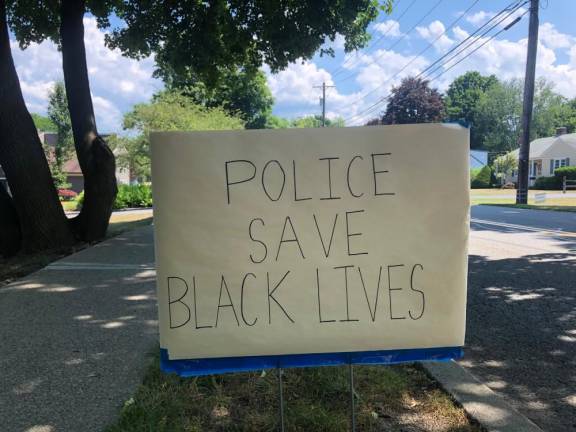Residents see ‘coded racism’ in firehouse sign
‘You can look at Warwick and see this small-town version of what everybody’s dealing with as a country’





The week before Independence Day, a sign went up outside a fire station in Warwick that hung heavy with meaning layered between the lines. It read:
We support the police
Stand for our flag
Kneel for God
“I was shocked,” said Daniel Mack, an artist and resident who snapped a picture of the sign. “Usually, that sign is congratulating graduates or reminding us about changing batteries in smoke alarms. This was so, so different. In my 30 years in Warwick, I don’t remember anything like it, especially in a public, tax-funded organization that serves the whole community. It really signals that we have a lot to talk about, together, respectfully.”
Complaints made their way to the all-volunteer fire department and up the line of command to George Schick, chairman of the Board of Fire Commissioners. On Friday, Schick drove down to Raymond Hose Fire Company No. 2 on West Street, took a picture and sent it to the other four Warwick fire commissioners – publicly elected volunteers who handle the administration of taxpayer dollars.
“This is on the firehouse, what do we all think?” Schick asked them. “We all decided it should come down.” He contacted Warwick Fire Chief Dan Schweikart and the sign came down by 6 p.m. that evening, replaced with, “God Bless America / Happy 4th of July.”
“Honestly, we kind of pride ourselves in servicing the whole community,” Schick said, “and when the board looked at the sign together we agreed that wasn’t the message that was on the sign and it wasn’t appropriate to be at one of our firehouses.”
The sign, explained Schick, is a company sign with no supervision from the larger department, usually used to promote events and fundraisers. “I guess in hindsight now, we probably need to add some oversight, which we will do, to make sure that whatever’s going to go up there gets vetted by the department or the district in the future.”
Is it dispiriting to think that firehouse signs may now have to be approved by corporate? “If you want to put that sign on your house, go right ahead,” Schick said, “but that’s not necessarily appropriate to have on a taxpayer-funded sign at the firehouse.”
Schick declined to name the person who put the sign up, but agreed to reach out to see if he would be willing to talk; by press time that person had not been in touch.
‘A trigger’
Though the words are gone, the feelings that prompted the message remain troubling, particularly coming from a department that is, at the moment, entirely white.
“I certainly found the sign to be coded racist language,” said Patricia McMillan, a CPA and business consultant who has run for local office. “And particularly insensitive given what we’re seeing now, where there’s a renewed effort to address the issue of over-policing in Black communities and the inordinate number of people who are dying at the hands of the police, the people who are supposed to be protecting us.”
McMillan, who is Black, is the daughter of an NYPD officer and the niece of a detective. She respects the police department and understands how difficult their job can be. Nevertheless, in the thick of Black Lives Matter, the biggest collective demonstration of civil unrest in a generation, the statement, “‘We support the police’ is sort of a trigger,” she said. “Basically what you’re saying is we don’t want to hear what you’re saying, we don’t care about that perspective, and police basically should take precedence and anything they do is okay. It’s an insult. It’s a slap in the face.”
The message also appears to belittle kneeling in protest, a gesture that has become iconic of the Black Lives Matter movement. NFL player Colin Kaepernick first took a knee during the National Anthem in 2016 to bring attention to policy brutality and the oppression of people of color.
‘This is a moment’
The sign is also disconcerting from a purely practical point of view, McMillan points out: if that’s the way the fire department feels, should people of color be afraid that if their house is on fire, they won’t show up?
It was not, however, completely out of nowhere. “I do think it’s indicative of a certain, I guess, belief in the community,” she said. Having run for Warwick Town Council and Orange County Legislature, McMillan has knocked on a lot of doors “and I got some of that – some of the coded racist stuff,” she said. “There were no blatant slurs said to me.” But she got questions like, “Could I really represent Warwick? It was a really hard job, maybe I should leave it to someone else.” Or, “Why are you coming to my door?”
The sign may have been wrongheaded, but it is part of the growing pains being experienced nationwide, said Warwick Village Mayor Michael Newhard. “As we go through these changes we need greater mindfulness and the realization that not everybody is perfect, and some folks will surely say something inappropriate, but that’s not bad – it’s how we reckon with these issues that speak to our own human fragility as well as strength,” said Newhard. “This is a moment we need words of encouragement and empathy to help us all find our common ground and to rebuild something better.”
Dueling signs and banners
The firehouse sign was one among many that have been popping up around Warwick in recent weeks, a neighborhood division writ in block letters. Three Black Lives Matter yard signs appear to duel with a handwritten Police Save Black Lives sign from opposite sides of Forester Avenue. A double-sided black banner hangs over West Street, applied for and paid for by a private citizen, emblazoned with “Racism Is Not Tolerated Here!” in all caps.
After getting calls about hanging a pro-police banner, the Village was considering allowing only banners promoting local events, “to stop possible banner wars,” said Newhard.
The blue line fight
The escalating sign situation hearkens back to the melee over the blue line painted down Warwick’s Railroad Avenue in the fall of 2016. Supporters saw the stripe as part of a nationwide show of support for law enforcement, while detractors felt it was a clear taking of sides in the divisive national debate on race and policing that was beginning to heat up. The tensions erupted in a Village Hall meeting in which Black Lives Matter was called a “hate group” and “deceitful radicals,” and Mayor Newhard was dressed down as “a coward” after he announced the line would be repainted red, white and blue.
Samantha Knowles, who grew up in Warwick, produced a documentary about the blue line controversy that aired on The New York Times website and went on to premiere at the Tribeca Film Festival. It was the first time that Knowles, who is Black, had heard race acknowledged openly in her family’s 20 years in Warwick. What she caught on film was revelatory.
The showdown would prove to be a harbinger of all that was about to unfold, beginning with the 2016 presidential election.
“It felt like such a microcosm of the country. Warwick was right on the pulse of what was happening nationally,” said Knowles. “And that feels like what’s happening again, you know? You can look at Warwick and see this small-town version of what everybody’s dealing with as a country.”
On the whole, Knowles had a beautiful time growing up here, notwithstanding moments of feeling “othered” – but Warwick’s placid exterior gives it the ability to fall into the trap of denial, she said. “It’s beautiful, it’s idyllic, it’s very comfortable to live there in a lot of ways, so a lot of issues can easily be swept under the rug.”
McMillan hears the same: “It’s not in our town. We don’t have an issue in Warwick – it’s really pretty ignorant,” she said. “There’s no way Warwick is separate from the world.”
‘Still so much left we haven’t talked about’
McMillan, who worked in corporate America for 40 years, considers herself fortunate not to have suffered anything worse than the day-to-day “micro-aggressions” that people of color live with: people not wanting to put change in your hand when transacting money; being asked out of nowhere by a police officer if the vehicle you’re driving is yours; being yelled at by an officer for asking a calm question.
“I always am appalled when I’ve been stopped by the police and they talk to me so disrespectfully, you know? I am a taxpayer. I pay the taxes that employ them,” she said. “The BIPOC community is very small in Warwick but we pay our taxes,” she said, using an acronym for Black, Indigenous and people of color.
Knowles wonders whether we have gotten further in the conversation in the last four years, or if the sign business is just the same intractable problem bubbling back up. In the wake of the blue line saga, “I think the town felt like they had some resolution, because they had this kind of coming together, and I say that with sort of air quotes,” said Knowles, 29, a documentary filmmaker who now lives in Brooklyn. “But in the film, I try to say there’s still so much left we haven’t talked about.”
This time is different
“We are still struggling with the issues the blue line exposed,” Newhard agreed. He hears from “frustrated and angry citizens who would prefer status quo,” a frustration that might be exacerbated by the pandemic’s enforced isolation. Still, he does not think we are doomed to relive our own version of Groundhog Day.
“The difference is the new groundswell of youthful voices who recognize social injustice and want to make a change,” he said.
This time, it’s not the same faces that were duking it out in Village Hall four years ago. It’s teens and twenty-somethings raising their voices, like the founders of the Hudson Valley Change Coalition, whose Black Lives Matter protest in Monroe drew 700 people. After getting a conference with Monroe-Woodbury school officials, the high school alums went into the two-and-a-half-hour meeting with a 23-point agenda and came out of it reproaching the district for milquetoast “appeasement.”
“I believe we are at a point of some true social shifts – maybe more ebb than flow but nonetheless real, and touching all of our communities,” said Newhard.
‘This history of discourse’
Has the fire department talked about pushing to diversify its ranks? Not yet, said Fire Commissioner Schick, “but it probably is worthy of discussion. I mean, we’re looking for people all the time, we need members. The department is open to anybody that wants to join, and if there is a way that that can get us more members, that would be great. The district meets once a month, and I will bring that up in the meeting as something we should probably pursue.”
Painful as it can be to find yourself completely at odds with your neighbors, Warwickians tend not to shy away from tough topics. Whether in strongly worded letters to the newspaper, village hall meetings or dueling street signs, “You know, we’re such a town that loves to talk,” said Knowles. “Warwick has this history of discourse; it’s embedded in the town. When these heated debates happen, it can frustrate people on both sides, but we do talk about it. If there’s one thing we’re going to do, it’s talk about it. I just wonder what happens beyond that.”
The conversation about race is happening in earnest now, and it will be particularly hard and extremely emotional, partly “because so many people think there’s nothing to talk about. We want things to stay the same,” said McMillan.
“Whether it’s something as awful as another Black person being killed, or a sign from the fire department, it gives us a chance to say, we should have these conversations,” said McMillan. “For those of us who’ve lived this our whole lives, these kinds of events do give us the opportunity to address the issue and say, ‘What are we going to go do about it?’”
“We kind of pride ourselves in servicing the whole community and when the board looked at the sign together we agreed that wasn’t the message that was on the sign and it wasn’t appropriate to be at one of our firehouses.”
George Schick, chairman of the Board of Warwick Fire Commissioners
“I certainly found the sign to be coded racist language. And particularly insensitive given what we’re seeing now, where there’s a renewed effort to address the issue of over-policing in Black communities and the inordinate number of people who are dying at the hands of the police, the people who are supposed to be protecting us.”
Patricia McMillan, a CPA and business consultant who has run for local office
“We are still struggling with the issues the blue line exposed (in 2016). The difference is the new groundswell of youthful voices who recognize social injustice and want to make a change.”
Village of Warwick Mayor Micheal Newhard
“There’s still so much left we haven’t talked about.”
Samantha Knowles, film producer